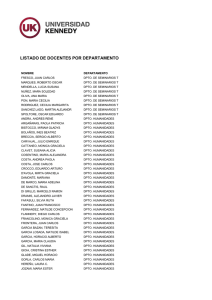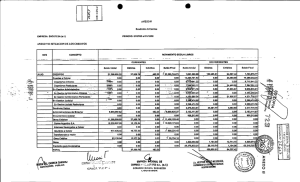Micrographic standarization of Baccharis L. species
Anuncio
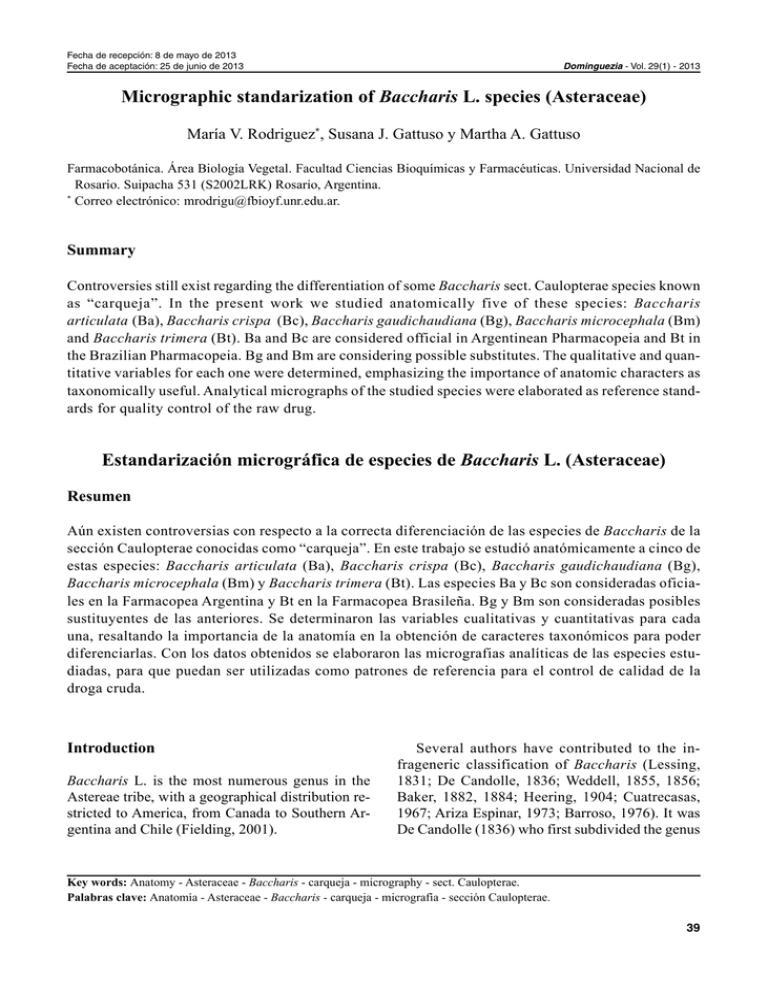
Fecha de recepción: 8 de mayo de 2013 Fecha de aceptación: 25 de junio de 2013 Dominguezia - Vol. 29(1) - 2013 Micrographic standarization of Baccharis L. species (Asteraceae) María V. Rodriguez*, Susana J. Gattuso y Martha A. Gattuso Farmacobotánica. Área Biología Vegetal. Facultad Ciencias Bioquímicas y Farmacéuticas. Universidad Nacional de Rosario. Suipacha 531 (S2002LRK) Rosario, Argentina. * Correo electrónico: [email protected]. Summary Controversies still exist regarding the differentiation of some Baccharis sect. Caulopterae species known as “carqueja”. In the present work we studied anatomically five of these species: Baccharis articulata (Ba), Baccharis crispa (Bc), Baccharis gaudichaudiana (Bg), Baccharis microcephala (Bm) and Baccharis trimera (Bt). Ba and Bc are considered official in Argentinean Pharmacopeia and Bt in the Brazilian Pharmacopeia. Bg and Bm are considering possible substitutes. The qualitative and quantitative variables for each one were determined, emphasizing the importance of anatomic characters as taxonomically useful. Analytical micrographs of the studied species were elaborated as reference standards for quality control of the raw drug. Estandarización micrográfica de especies de Baccharis L. (Asteraceae) Resumen Aún existen controversias con respecto a la correcta diferenciación de las especies de Baccharis de la sección Caulopterae conocidas como “carqueja”. En este trabajo se estudió anatómicamente a cinco de estas especies: Baccharis articulata (Ba), Baccharis crispa (Bc), Baccharis gaudichaudiana (Bg), Baccharis microcephala (Bm) y Baccharis trimera (Bt). Las especies Ba y Bc son consideradas oficiales en la Farmacopea Argentina y Bt en la Farmacopea Brasileña. Bg y Bm son consideradas posibles sustituyentes de las anteriores. Se determinaron las variables cualitativas y cuantitativas para cada una, resaltando la importancia de la anatomía en la obtención de caracteres taxonómicos para poder diferenciarlas. Con los datos obtenidos se elaboraron las micrografias analíticas de las especies estudiadas, para que puedan ser utilizadas como patrones de referencia para el control de calidad de la droga cruda. Introduction Baccharis L. is the most numerous genus in the Astereae tribe, with a geographical distribution restricted to America, from Canada to Southern Argentina and Chile (Fielding, 2001). Several authors have contributed to the infrageneric classification of Baccharis (Lessing, 1831; De Candolle, 1836; Weddell, 1855, 1856; Baker, 1882, 1884; Heering, 1904; Cuatrecasas, 1967; Ariza Espinar, 1973; Barroso, 1976). It was De Candolle (1836) who first subdivided the genus Key words: Anatomy - Asteraceae - Baccharis - carqueja - micrography - sect. Caulopterae. Palabras clave: Anatomía - Asteraceae - Baccharis - carqueja - micrografía - sección Caulopterae. 39 Rodriguez y cols. into sections (sect.), based mainly on leaf morphology. More recently, Giuliano (2001) subdivided the 96 Argentine Baccharis species into 15 sect. Among them, sect. Caulopterae DC is characterized by the presence of species with winged stems. Species of this sect. are known popularly as “carqueja” and two of them, i.e., Baccharis articulata (Lam.) Pers. and Baccharis crispa Spreng. are included in the Farmacopea Nacional Argentina Ed. VI (1978) and a third one, Baccharis trimera (Less.) DC. in the Farmacopéia Brasileira Ed. IV (2002). They are used as hepatic, stimulating to bile secretion, diuretic drugs, for ulcer healing and as external antiseptics, in infusions or decoctions. (Hieronymus, 1882; Sorarú and Bandoni, 1978; Toursarkissian, 1980; Martínez Crovetto, 1981; Correa, 1985). Although there is abundant information about the genus in the literature, there are many controversies regarding the correct nomenclature as many synonyms exist especially in sect. Caulopterae DC. (Arizar Espinar, 1973; Lonni et al., 2005; SimõesPires et al., 2005; Müller, 2006). The species in sect. Caulopterae that have been most studied anatomically are B. articulata, B. crispa and B. trimera (Metcalfe and Chalk, 1972; Ariza Espinar, 1973; Cortadi et al., 1999; Barboza et al., 2001; Müller, 2006; Freire et al., 2007). Müller (2006) differentiated Baccharis genistelloides subsp. crispa (here: B. trimera), that contains tufts of 3-7-celled clavate uniseriate hairs, from B. articulata, that contains tufts of 46-celled flagellate hairs. In contrast, Freire et al. (2007) reported that the trichomes of four species of the Caulopterae sect., B. articulata, B. gaudichaudiana DC., B. microcephala (Less.) DC. and B. trimera, are bulbiferous flagellate with triangular apical cells; however B. trimera differed from the other three species due to its anisocytic stomata. Several authors also reported this type of stomata in B. articulata (Ariza Espinar, 1973; Cortadi et al., 1999; Barboza et al., 2001). In addition to these diverse studies, it is important to take in account that Baker (1882; 1884) considered that B. gaudichaudiana was the same species as B. articulata. Ariza Espinar (1973) studied the anatomy of the two official Argentine species (B. articulata and B. crispa) and Cortadi et al., (1999) reported on the anatomy of the winged 40 stems of three species of the Caulopterae sect., B. articulata, B. crispa and B. trimera, finding some differences between them. Another study aimed to discriminate two or three Baccharis species of the Caulopterae sect. by using micrographic characters or chemical composition of vouchers, only involved the presence or absence of isolated metabolites (Gianello et al., 2000, Rodríguez et al., 2008). However, the information from these studies is incomplete and therefore they are inconclusive about the proper differentiation of some species of the Caulopterae sect. and so, there is a general consensus that a complete morphoanatomical examination of the some winged stem species to obtain both the qualitative and quantitative variables is needed. Therefore the aim of this work is to perform a morphoanatomical exhaustive study of three official “carqueja” species: B. articulata, B. crispa and B. trimera and two possible substituents: B. gaudichaudiana and B. microcephala to achieve micrographic standardization of them. Materials Plant material Specimens from the following herbaria: UNR, SI, CTES, BAF and LP (abbreviations according Holmgren et al., 1990), or fresh material collected by the authors during five collecting campaigns in 2004, 2005, 2006, 2007 and 2008, were examined; all materials were collected with flowers and/or fruits to enable identification, checked by the authors and stored in the UNR herbarium (Table 1). Methods Morphoanatomy Fresh material was fixed in F.A.A. (70º ethanol, glacial acetic acid, formaldehyde and water 50:5:30:15). The herbarium material was hydrated in boiling water with added drops of detergent. Zeiss MC 80 Axiolab light microscope equipped with a photographic camera and Nikon Alphaphot YS light microscope with polarized light and a Nikon Type 104 stereoscopic drawing tube were used for the microscopic examination. Dominguezia - Vol. 29(1) - 2013 Baccharis crispa Bacchari accharis Table 1.- Data of analysed samples of Baccharis species Site Prov. of Misiones Dpto. Cainguas, Loc. Campo Grande, Ruta Nac. 8 Dpto. Apóstoles Prov. of Entre Ríos Dpto. Federación, Loc. Santa Ana Dpto. Colón, Loc. Colón, Parque Nacional El Palmar Dpto. Uruguay, Loc. Pronunciamiento Dpto. Uruguay, Loc. Pronunciamiento Prov. of Chaco Dpto. Sgto. Cabral, Parque Nacional Chaco Prov. of Santa Fe Dpto. Capital, Loc. Santa Fe Dpto. Capital, Loc. Santa Fe Dpto. Belgrano, Loc. Las Rosas Dpto. Rosario, Loc. Rosario Dpto. Rosario, Loc. Rosario Dpto. Rosario, Loc. Arroyo seco Prov. of Buenos Aires Pergamino, cruce de Rutas 188 y 18 camino a Bavio Prov. of Tucumán Villa Nougues Villa Nougues Prov. of Córdoba Dpto. Punilla, Loc. Ongamira, Paraje:”Las dos Lunas” Dpto. Punilla, Loc. Asconchinga, “Potrero de los peones” Dpto. Punilla, Loc. La Cumbre Dpto. Calamuchita, camino a Atos Pampa, a 1 km de la Ruta Villa Gral. Belgrano y La Cumbrecita Dpto. Calamuchita, Loc. Yacanto de Calamuchita Dpto. Calamuchita, Loc. El Durazno Dpto. Calamuchita, Loc. El Durazno Dpto. Calamuchita, Loc. El Durazno Dpto. Calamuchita, Loc. El Durazno Dpto. Calamuchita, Loc. El Durazno Dpto. Calamuchita, Loc. El Durazno Prov. of Buenos Aires Tandil, en el cerro Albión Prov. of Córdoba Dpto. Punilla, Loc. Ascochinga, “Potrero de los peones” Dpto. Punilla, 5 km al O de Capilla del Monte Dpto. Punilla, 5 km al O de Capilla del Monte Dpto. Calamuchita, Loc. Los Reartes, puente San Ignacio de Loyola Dpto. Calamuchita, Loc. Yacanto de Calamuchita Dpto. Calamuchita, Loc. Mina Clavero Prov. of San Luis Dpto. Cnel. Pringles, camino a la Mina Carolina Dpto. La Capital, Loc. El Volcán Prov. of Mendoza Dpto. Las Heras, Loc. Potrerillos, Salto Dpto. Luján de Cuyo, Loc. Luján, “Las Chacritas” Dpto. Tupungato, a 5 km al O de la estancia “La Selva” Dpto. Tunuyán, entre Tunuyán y El Manzano Date Voucher 1/VIII/1987 X/1977 Vanni et al. 976 (CTES) Cabrera 28469 (SI) 24/IX/1961 11/II/2006 VIII/ 2005 11/II/2006 Burkart 22823 (SI) Gattuso S. 770 (UNR) Gattuso S. 807 (UNR) Gattuso S.769 (UNR) 23/XI/1991 Fortunato 2593 (SI) VIII/ 2005 13/XII/2005 15/IX/2005 18/I/2007 18/I/2007 VIII/ 2007 Gattuso M. 189 (UNR) Gattuso M. 190 (UNR) Gattuso M. 186 (UNR) Gattuso S. 854 (UNR) Gattuso S. 855 (UNR) Mc Cargo J. 29 (UNR) 2/V/2006 30/III/1975 Gattuso M. 222 (UNR) Zardini 592 (SI) 12/VII/1907 X/1966 Lizer 55 (SI) Esk 02513 (SI) 25/II/2006 25/II/2006 I/2007 19/IV/2005 Gattuso S. 789 (UNR) Gattuso S. 790 (UNR) Gattuso S. 856 (UNR) Gattuso M. 183 (UNR) 11/I/2006 4/III/2006 4/III/2006 4/III/2006 4/III/2006 4/III/2006 4/III/2006 Gattuso M. 191 (UNR) Gattuso S. 799(UNR) Gattuso S. 800 (UNR) Gattuso S. 801 (UNR) Gattuso S. 802 (UNR) Gattuso S. 803 (UNR) Gattuso S. 804 (UNR) 3/III/1946 Krapovickas 2989 (SI) 25/II/2006 19/III/2005 19/III/2005 11/III/2006 18/IV/2005 III/1940 Gattuso S. 791 (UNR) Gattuso M.156 (UNR) Gattuso M.157 (UNR) Gattuso M. 208 (UNR) Gattuso M.153 (UNR) Valencia 2376 (SI) 28/IV/1986 1/IV/1983 Volponi 939 (SI) Agiglia 6486 (SI) 15/I/2006 20/III/1944 17/IV/1986 Gattuso S. 778 (UNR) Covas 2038 (SI) Leuenberger & Arroyo 3571 (SI) Covas (SI) 10/III/1945 41 Rodriguez y cols. Baccharis microcephala Baccharis gaudichaudiana Table 1.- Data of analysed samples of Baccharis species (cont.) Site Prov. of Misiones Dpto. San Ignacio, Loc. Jardín América Dpto. San Ignacio, Loc. San Ignacio Dpto. San Ignacio, Loc. San Ignacio Dpto. San Ignacio, Loc. San Ignacio Dpto. San Ignacio, Loc. San Ignacio Dpto. San Ignacio, Loc. San Ignacio, camino de Loreto a San Ignacio Dpto. Candelaria, Loc. Santa Ana Dpto. Leandro N. Alem, Loc. Cerro Azul Prov. of Jujuy Dpto. Santa Bárbara, Loc. Abra de los Morteros Dpto. Capital, Loc. Capilla Prov. of Misiones Dpto. Candelaria, Loc. Loreto Dpto. Apóstoles, Ruta 14, al NE del cruce a San José Prov. of Corrientes Dpto. Ituzaingó, Ruta Nac. 12 a 10 km de Ituzaingó Dpto. Mercedes, Bañado del Ayuí Dpto. Mercedes, Cuenca del Ayuí Dpto. Monte Caseros, km 173, Campo Gral. Ávalos Prov. of Entre Ríos Dpto. Uruguay, Loc. Concepción del Uruguay Dpto. Paraná, Paracao, barrancas frente a cuarteles Delta del Paraná, Arroyo Martínez Prov. of Formosa Dpto. Laishi, Reserva “El Bagual” Prov. of Santa Fe Dpto. Rosario, Loc. Rosario The wings were dehydrated with increasing concentrations of alcohol and coated with goldpalladium. Observations were made using a JEOL scanning electron microscope, model 35-CI. Surface view of epidermis The wings of the stems were diaphanised according to Strittmatter’s technique (1973) when KOH 10% was used to remove the resin layer. Cross- sections of winged stems The material was dehydrated in increasing ethanol concentrations, then with ethanol/xylene and xylene and lastly embedded in paraffin (Gattuso and Gattuso, 2002). Cuts were performed manually with a Minot microtome, obtaining 12 µm thick sections. Diluted Safranine and Safranine-Fast green were used for staining (Strittmatter, 1979). The material was also dehydrated in increasing acetone concentrations, 42 Date Voucher 20/II/2006 12/X/2005 12/X/2005 11/III/2005 20/II/2006 11/X/1975 3/IX/1912 11/III/2005 Gattuso, M. 209 (UNR) Gattuso M. 177 (UNR) Gattuso M.179 (UNR) Gattuso M. 181 (UNR) Gattuso, M. 210 (UNR) Zardini et al. 658 (SI) Rodríguez 539 (SI) Gattuso, M. 182 (UNR) IX/1976 22/IX/1981 Cabrera 27975 (SI) Ahumada 4324 (SI) II/1945 20/II/2006 Montes s. n. (SI) Gattuso M. 212 (UNR) 25/I/1976 Romancksuk et al. 367 (SI) Gattuso M. 185 (UNR) Gattuso M. 184 (UNR) Schinini et al. 17491 (CTES) 20/X/2005 20/X/2005 21/2/1979 6/X/1950 31/X/1962 13/X/1944 Hunziker 4384 (SI) Boelcke & Correa 9137 (BAA) Boelcke 942 (SI) 17/II/2006 Gattuso M. 211 (UNR) 27/X/2005 Gattuso S. 768 (UNR) acetone/propylene oxide and propylene oxide and embedded in Spurr’s epoxy resin (Union Carbide International Co.). The stem segments were cut into 1 µm sections obtained with an ultramicrotome, equipped with a diamond knife. Toluidine Blue 1% and Acid Fuchsin 1% were used for staining (D’Ambrogio, 1986). Crystals were observed using weak diluted acid and polarized light analysis (Johansen, 1940). Results and discussion Alate stems anatomy – Qualitative and Quantitative variables Table 2 summarizes the differential anatomical qualitative variables of five species of Baccharis with winged stems. Dominguezia - Vol. 29(1) - 2013 Table 1.- Data of analysed samples of Baccharis species (cont.) Bacharis trimera Site Prov. of Misiones Dpto. Guaraní, Ruta Prov. 21, camino de Paraíso a Moconá, a 23 km de la Ruta Nac. 14 Prov. of Corrientes Dpto. Mercedes, Loc. Mercedes Dpto. Mercedes, Loc. Mercedes Dpto. Paso de Los Libres, Estancia “El Recreo”, costa del Río Uruguay Loc. Bonpland Loc. Bonpland Dpto. Alvear, ruta 14 entre Santo Tomé y Alvear Prov. of Entre Ríos Dpto. Federación, Loc. Colonia La Argentina Loc. Isthílart, camino a Calchaquí Dpto. Colón, Parque Nacional El Palmar Dpto. Colón, Parque Nacional El Palmar Dpto. Colón, Parque Nacional El Palmar Dpto. Colón, Parque Nacional El Palmar Dpto. Uruguay, Loc. Pronunciamiento Dpto. Uruguay, Loc. Pronunciamiento Dpto. Uruguay, Loc. Pronunciamiento Dpto. Uruguay, Loc. Pronunciamiento Dpto. Uruguay, Loc. Pronunciamiento Dpto. Uruguay, Loc. Pronunciamiento Dpto. Uruguay, Colonia Dolores Dpto. Uruguay, Loc. Concepción del Uruguay, Colonia Elías Prov. of Buenos Aires Pergamino, cruce de Rutas 188 y 18 Elizalde, Praderas Berisso, Ruta 11, km 11 Punta Lara Batolomé Bavio Tronquist, Sierra de la Ventana Prov. of Santa Fe Dpto. Rosario, Loc. Rosario Dpto. Rosario, Loc. Rosario San Marcos Prov. of Salta Dpto. Santa Victoria, Loc. Los Toldos, Río Toldos, frente a la Quebrada del Astillero Prov. of Catamarca Dpto. Andalgalá, Loc. El Condado Table 3 summarizes the anatomical quantitative variables of the same species and table 4 shows the quantitative variables that differ between these five species. Anomocytic stomata are present in the five studied species and this coincides with the reports of Metcalfe and Chalk (1972) for the Asteraceae; Cortadi et al. (1999) for B. articulata, B. crispa Date Voucher 28/IV/1997 Morrone et al. 2177 (SI) 8/VII/2005 2/II/2006 19/II/1979 Gattuso M. 187 (UNR) Gattuso M. 213 (UNR) Schinini 17333 (SI) 13/III/2005 13/III/2005 22/II/2006 Gattuso M. 152 (UNR) Gattuso M. 166 (UNR) Gattuso M. 244 (UNR) 3/II/1983 Guaglianone et al. 1238(SI) Troncoso 1562 (SI) Gattuso M. 148 (UNR) Gattuso M. 150 (UNR) Gattuso S 772 (UNR) Gattuso S. 773 (UNR) Gattuso M. 154 (UNR) Gattuso S. 771 (UNR) Gattuso S. 774 (UNR) Gattuso S. 780 (UNR) Gattuso S. 808 (UNR) Gattuso S. 809 (UNR) Gattuso M. 155 (UNR) Gattuso S. 816 (UNR) 18/I/1977 14/III/2005 14/III/2005 11/II/2006 11/II/2006 11/XII/2004 11/II/2006 11/II/2006 11/II/2006 22/III/2006 22/III/2006 11/XII/2004 22/III/2006 2/V/2006 14/III/1940 8/IV/2006 3/III/2002 IV/2003 3/III/1984 Gattuso M. 223 (UNR) Cabrera 6337 (SI) Gattuso M. 220 (UNR) Lara (BAF) Rivas (BAF) Hunziker & Wulff 12055 (SI) 27/X/2005 IX/1997 16/II/1941 Gattuso S. 767 (UNR) Reyna (LP) Nicora 17735 (SI) 30/X/1987 Novara 7129 (SI) 4/V/1916 Jorgensen 1418 (SI) and B. trimera and Freire et al. (2007) for B. microcephala. Cyclocytic stomata in B. articulata and anisocytic stomata in B. trimera were previously reported by Pertusi (1987). Other authors also reported anisocytic stomata in B. trimera (Cortadi et al., 1999; Freire et al., 2007) and B. crispa (Ariza Espinar, 1973; Cortadi et al., 1999; Barboza et al., 2001; Freire et al., 2007). 43 Rodriguez y cols. Figure 1.- Stomata type present in the five studied species A-D: Scanning electron micrograph; E: light micrograph. A-B: ciclocytic stomata of B. gaudichaudiana and B. articulata, respectively; C: anisocytic stomata of B. trimera; D-E: anomocytic stomata of B. crispa and B. microcephala, respectively. Table 2.- Differential anatomical qualitative variables of five species of sect. Caulopterae with winged stems Ba Bc Wings Bg Bm Bt ST Anomocytic Ciclocytic Anomocytic Anisocytic Anomocytic Ciclocytic Anomocytic Anomocytic Anisocytic UTT 3-4 basal cells, acutely curved, terminal cell not very long, with the subterminal cell larger than other cells and terminal cell narrower than remaining cells of the trichome (flagellate trichomes) 2-3 basal cells wider than long. Terminal cell is acute at apex and presents thick cell wall, which gives a smooth appearance to its surface (armed trichomes) 3-4 basal cells, acutely curved, terminal cell not very long, with the subterminal cell larger than other cells and terminal cell narrower than remaining cells of the trichome (flagellate trichomes) 3-4 basal cells, acutely curved terminal cell not very long, with the subterminal cell larger than other cells and the terminal cell narrower than remaining cells of the trichome (flagellate trichomes) 3-4 basal cells, curve triangular terminal cell, not very long, shaped “nails”, with thin cell walls, giving it a rough appearance on the surface, with subterminal cell as wide as the terminal cell and not longer than the others. (clavate richomes). MB Presence of laminar collenchyma Absence of laminar collenchyma Presence of laminar collenchyma Presence of laminar collenchyma (only 1 or 2 rows) Absence of laminar collenchyma MB: marginal bundles; ST: stomata type; UTT: uniseriate trichome type. 44 Dominguezia - Vol. 29(1) - 2013 Anisocytic stomata were also reported in B. articulata by Ariza Espinar (1973), Cortadi et al. (1999) and Barboza et al. (2001), but in our study no anisocytic stomata were observed for this species. Freire et al. (2007) observed cyclocytic stomata in B. articulata and B. gaudichaudiana, in agreement with our results (Figure 1). With regard to the uniseriate type of trichome, we distinguished at least three different types of uniseriate trichomes in the five studied species (Figure 2). Müller (2006) reports tufts of 3-7-celled clavate uniseriate hairs in Baccharis genistelloides subsp. crispa. In our investigation we observed this type of trichome in B. trimera, but not in B. crispa, which presented the trichome type described as a whip by Ariza Espinar (1973), or 1-armed trichome by Freire et al. (2007), and Metcalfe and Chalk (1972). Freire et al. (2007) described the bulbiferous flagellate tri- chome type for B. articulata, B. gaudichaudiana, B. microcephala and B. trimera. In our study, we observed this trichome type in the first three species mentioned but not in B. trimera. Ariza Espinar (1973) reports the whip trichome type in most species of Baccharis with different lengths of the terminal cell according to the species and uniseriate glandular and whip trichomes in tufts of B. articulata. There is collenchyma in the wing margins of B. articulata and B. gaudichaudiana, which make these species different from B. crispa and B. trimera, that have a conspicuous cap of schlerenchyma fibres replacing the collenchyma in this position. B. microcephala presents only 1-2 rows of collenchyma in the wing margins. We propose that the presence of subepidermal collenchyma in the wing margin is a differential character between some of the species (Figure 3). Figure 2.- Uniseriate type of trichome Figure 3.- Light micrograph of a wing transverse section A, C-E: Light micrograph and B: scanning electron micrograph. A-C: flagellate trichomes of B. articulata, B. gaudichaudiana and B. microcephala, respectively; D: armed trichomes of B. crispa; E: clavate trichomes of B. trimera. Arrows indicate terminal cells (white) and subterminal cells (black). A-B: Presence of collenchyma in the wing margin of B. articulata and B. gaudichaudiana, respectively; C: Presence of 1-2 rows of collenchyma in the wing margin of B. microcephala; D-E: Absence of collenchyma in the wing margin of B. crispa and B. trimera, respectively (Co: collenchyma; f: fibres; MB: marginal bundle; SSS: secreting schizogenous structures). 45 Rodriguez y cols. Stem (cross-section) Table 3.- Quantitative variable's mean and standard error of B. articulata Ba Bc Bg Bm Bt Perimeter (mm) 02.14 ± 0.460 003.00 ± 0.620 03.17 ± 0.660 03.55 ± 0.310 003.10 ± 0.840 Number of SSS 03.00 ± 1.000 001.00 ± 1.000 08.00 ± 2.000 01.00 ± 1.000 008.00 ± 3.000 Number of SSS per Stem (mm) 01.23 ± 0.380 000.35 ± 0.300 02.51 ± 0.590 00.28 ± 0.180 002.77 ± 1.440 SSS length (µm) 17.00 ± 5.330 024.80 ± 8.670 51.67 ± 13.29 25.50 ± 10.75 058.83 ± 14.08 SSS width (µm) 28.33 ± 7.200 014.80 ± 5.760 34.00 ± 14.42 12.50 ± 3.000 029.33 ± 10.86 000.8 ± 0.230 001.74 ± 0.870 02.94 ± 0.620 01.14 ± 0.470 002.60 ± 1.120 Number of SSS 03.00 ± 1.000 002.00 ± 2.000 11.00 ± 3.000 01.00 ± 1.000 009.00 ± 4.000 Number of SSS per Wing (mm) 03.73 ± 1.860 001.31 ± 1.120 03.60 ± 1.130 00.53 ± 0.510 003.50 ± 0.860 SSS length (µm) 40.67 ± 20.42 022.80 ± 4.380 83.71 ± 26.26 46.43 ± 17.27 106.67 ± 30.55 SSS width (µm) 33.00 ± 10.49 017.00 ± 5.830 48.00 ± 17.17 23.43 ± 3.090 054.50 ± 20.43 Stomata density 47.00 ± 7.000 119.00 ± 29.00 48.00 ± 10.00 82.00 ± 5.000 138.00 ± 29.00 Stomata index 07.03 ± 0.970 13.00 ± 1.420 05.00 ± 0.510 06.54 ± 1.000 013.83 ± 1.860 Stomata length (µm) 53.27 ± 3.680 29.70 ± 0.740 58.54 ± 3.950 40.12 ± 5.630 031.93 ± 2.270 Stomata width (µm) 41.03 ± 3.210 25.83 ± 1.180 49.00 ± 6.370 31.76 ± 3.720 028.97 ± 2.890 Tuft of trichomes density 22.00 ± 5.000 28.00 ± 4.000 34.00 ± 18.00 20.00 ± 10.00 016.00 ± 7.000 Wings (diaphanised) Wings (cross-section) Wings width Ba: B. articulata; Bc: B. crispa; Bg: B. gaudichaudiana; Bm: B. microcephala; Bt: B. trimera; SSS: schizogenous secreting structure. 46 Dominguezia - Vol. 29(1) - 2013 Table 4.- Summary of quantitative variables that differ between sect. Caulopterae species with winged stems in Argentina Bc Density, index, length and width of stomata, Stem number of SSS, Stem length SSS Bg Bm Bt Width wing, Wing number of SSS Density, length and width of stomata, Number of SSS per wing Density, index, length and width of stomata, Stem number of SSS, Stem length SSS, Width wing, Wing number of SSS, Wing length SSS Stomata index Stem number of SSS, Number of SSS per Stem, Stem length SSS, Wing number SSS, Number of SSS per wing, Wing length SSS, Wing width SSS Density, length and width of stomata, Stem number of SSS, Number of SSS per Stem, Wing number of SSS, Number of SSS per Wing Density, index, length and width of stomata Density, index, length and width of stomata, Stem number of SSS, Number of SSS per Stem, Wing number SSS, Wing length SSS Density, index and lengthof stomata, Stem number of SSS, Number of SSS per Stem, Stem length SSS, Wing number SSS, Number of SSS per wing, Wing length SSS Bt Bm Bg Bc Ba Ba Quantitative variables show statistically significant differences between the species (p < 0.05). The presence of subepidermal collenchyma in the wing margin for B. articulata has been previously reported (Ariza Espinar, 1973; Müller, 2006). It is interesting to note that Müller (2006) also reported the presence of collenchyma in B. genistelloides in this position; however our results are not in agreement with previous reports as we did not observed any collenchyma in B. crispa and B. trimera. Cortadi et al. (1999) reported the presence of 1 row of collenchyma in B. trimera and its absence in B. crispa. Conclusion According to these results, we conclude that we can characterize the five winged stem species of sect. Caulopterae using the selected qualitative and quantitative variables determined in this study. As part of quality control of herbal medicines, five micrographic monographies of the studied species were elaborated (Figures 4, 5, 6, 7 and 8). 47 Rodriguez y cols. Figure 4.- Baccharis articulata A: 2-winged stem representative diagram; B: detail of the wing margin with collenchyma and a secreting schizogenous structure; C: Stem detail, as indicated in A, with a secreting schizogenous structure; D-E: trichomes, D: nonglandular; E: glandular. F: Surface view of the wing epidermis showing anomocytic stomata; G: polyhedral crystals of calcium oxalate; H: wing vascularization; e: endodermis; sss: secreting schizogenous structure. 48 Dominguezia - Vol. 29(1) - 2013 Figure 5.- Baccharis crispa A: 3-winged stem representative diagram; B: Stem detail, as indicated in A, with a secreting schizogenous structure; C: detail of the wing margin with fibres and a secreting schizogenous structure: D: detail of wing vascular bundles with a secreting schizogenous structure; E: wing vascularization; F: Surface view of the wing epidermis showing anisocytic stomata and striated cuticle; G: Surface view of glandular and non-glandular tuft of trichomes; H: nonglandular trichome; I: glandular trichome; J: crystals of calcium oxalate. 49 Rodriguez y cols. Figure 6.- Baccharis trimera A: 3-winged stem representative diagram; B: Stem detail, as indicated in A, with a secreting schizogenous structure; C: detail of the wing margin with fibres and a secreting schizogenous structure; D: detail of wing vascular bundles with a secreting schizogenous structure; E: wing vascularization; F: Surface view of the wing epidermis showing anisocytic stomata; G: Surface view of glandular and non-glandular tuft of trichomes; H: cross section of G; I: glandular trichome; J: crystals of calcium oxalate. 50 Dominguezia - Vol. 29(1) - 2013 Figure 7.- Baccharis gaudichaudiana A: exomorphology of winged stem; B, C, D, F: winged stem cross section; B: 2-winged stem representative diagram; C: stem detail, as indicate in B, with a secreting schizogenous structure; D: wing margin detail, as indicate in B, with a secreting schizogenous structure; F: raised estomata; G-H: wing surface view; G: epidermis with anomocytic stomata; H: vascular endings with dilated tracheids; I: wing vascularization; J-P: leaf; J: external morphology; K-P: internal morphology; K-M: surface view; K: architecture; L-M: epidermis; L: adaxial; M: abaxial, both with anomocytic stomata; N-P: cross section; N: margin detail; O: lamina, representative diagram; P: middle nerve detail; Q-T: trichomes; Q: non-glandular; R-T: glandular; E: polyhedral crystals of calcium oxalate. 51 Rodriguez y cols. Figure 8.- Baccharis microcephala A: 3-winged stem representative diagram; B: wing margin detail with collenchyma, as indicate in A; C: stem detail, as indicate in A, with a secreting schizogenous structure; D-F: wing surface view; D: epidermis with anomocytic stomata and striated cuticle; E: wing vascularization; F: dilated vascular endings detail; G: glandular and non-glandular tuft of trichomes; H: glandular trichome; I: polyhedral crystals of calcium oxalate. 52 Dominguezia - Vol. 29(1) - 2013 References Ariza Espinar, L. (1973). “Las especies de Baccharis (Compositae) de Argentina Central”. Boletín de la Academia Nacional de Ciencias de Córdoba 50: 1-305. Baker, J.G. (1882-1884). “Compositae III. Asteroideae, Inuloideae. IV. Heliathoideae, Anthemideae, Senecionideae, Cynaroideae, Ligulatae, Mutisiaceae” in: Martius, C.F. and Eichler, A.W. (eds) Flora brasiliensis: enumeratio plantarum. F Fleischer, Leipzig, Munich: 1-100. Barboza, G.E.; Bonzani, N.; Filippa, E.M.; Luján, M.C.: Morero, M.; Bugatti, M.; Decolatti, N.; Ariza Espinar, L. (2001). Baccharis articulata (Lam.) Pers. En: Atlas Histomorfológico de Plantas de Interés Medicinal. Universidad Nacional de Córdoba: 32-35. Barroso, G.M. (1976). “Compositae, Subtribo Baccharidinae Hoffman. Estudo das espécies ocorrentes no Brasil”. Rodriguésia 28: 3-273. Cortadi, A.; Di Sapio, O.; Mc Cargo, J.; Scandizzi, A.; Gattuso, S.; Gattuso, M. (1999). “Anatomical studies of Baccharis articulata, Baccharis crispa and Baccharis trimera, ‘Carquejas’ used in folk medicine”. Pharmaceutical Biology 37: 357-365. Correa, M.P. (1985). Dicionário das plantas úteis do Brasil e das exóticas cultivadas. IBDF, Río de Janeiro. Cuatrecasas, J. (1967). “Revisión de las especies colombianas del género Baccharis”. Revista de la Academia Colombiana de Ciencias Exactas 13: 5-102. D’Ambrogio, A. (1986). Manual de Técnicas en Histología Vegetal. Hemisferio Sur, Buenos Aires. De Candolle, A.P. (1836). “Compositae: Baccharis”. In: Prodromus Systematis Naturalis Regni Vegetabilis 5: 398-429. Farmacopea Nacional Argentina VI ed. (1978). Codex Medecamentarius Argentino. Buenos Aires. Farmacopéia Brasileira IV Edição. (2002). Atheneu Editora S. A. Sao Paulo. Fielding, R.R. (2001). “Baccharis: A genus of the Asteraceae new to Canada”. In: Payne S.H (ed.) Proceedings of the Nova Scotian Institute of Science. Halifax, Nova Scotia: 214-215. Freire, S.E.; Urtubey, E.; Giuliano, D.A. (2007). “Epidermal characters of Baccharis (Asteraceae) species used in traditional medicine”. Caldasia 29: 23-38. Gattuso, M.A.; Gattuso, S.J. (2002). Técnicas Histológicas en Material Vegetal. UNR Editora, Rosario. Gianello, J.C.; Ceñal, J.P.; Giordano, O.S.; Tonn, C.E.; Petenatti, M.E.; Petenatti, E.M.; Del Vitto, L.A. (2000). “Medicamentos Herbarios en el Centro-Oeste Argentino. II. ‘Carquejas’: Control de Calidad de las Drogas Oficiales y Sustituyentes”. Latin American Journal of Pharmacy 19: 99-103. Giuliano, D.A. (2001). “Clasificación Infragenérica de las especies argentinas de Baccharis (Asteraceae, Astereae)”. Darwiniana 39: 138154. Heering, W.C. (1904). “Die Baccharis-Arten des Hamburger Herbars”. Jahrbuch der Hamburgischen Wissenschaftlichen Anstalten 21: 1-46. Hieronymus, J. (1882). Plantae Diaforicae, Florae Argentinae”. Boletín de la Academia Nacional de Ciencias de Córdoba 4: 159-160. Holmgren, P.K.; Holmgren, N.H.; Barnett, L.C. (1990). Index Herbariorum. New York Botanical Garden, New York. Johansen, D.A. (1940). Plant microtechnique. MacGraw-Hill, New York. Lessing, C.F. (1831). “Synanthereae: MolinsAlatae”. Linnaea 6: 83-170. Lonni, A.A.S.G.; Scarminio, I.S.; Silva, L.M.C.; Ferreira, D.T. (2005). “Numerical Taxonomy Characterization of Baccharis Genus Species by Ultraviolet-Visible Spectrophotometry”. Analytical Science 21: 235-239. Martínez Crovetto, R. (1981). “Plantas utilizadas en medicina en el NO de Corrientes”. Fundación Miguel Lillo, Tucumán. Metcalfe, C.R.; Chalk, R. (1972). Anatomy of the Dicotyledons. Clarendon Press, Oxford, London. Müller, J. (2006). “Systematics of Baccharis (Compositae, Astereae) in Bolivia, including an overview of the genus”. The American Society of Plant Taxonomists, Michigan. Pertusi, L.A. (1987). “Caracteres foliares de especies de Baccharis (Compositae) tóxicas para el ganado, de la cuenca del arroyo Sauce Corto (Partido de Coronel Suárez, Provincia de Buenos Aires)”. Revista del Museo de La Plata 93: 119191. Rodríguez, M.V.; Gattuso, S.J.; Gattuso, M.A. 53 Rodriguez y cols. (2008). “Baccharis crispa and Baccharis trimera (Asteraceae): A Review and New Contributions for their Micrographic Normalization”. Latin American Journal of Pharmacy 27: 387-397. Simões-Pires, C.A.; Debenedetti, S.; Spegazzini, E.; Mentz, L.A.; Matzenbacher, N.I.; Limberger, R.P.; Henriques, A.T. (2005). “Investigation of the essential oil from eight species of Baccharis belonging to Sect. Caulopterae (Asteraceae, Astereae): a taxonomic approach”. Plant Systematics and Evolution 253: 23-32. Sorarú, S.B.; Bandoni, A.L. (1978). Plantas de la 54 Medicina Popular Argentina. Albatros, Buenos Aires. Strittmatter, C. (1973). “Nueva Técnica de Diafanización”. Boletín de la Sociedad Argentina de Botánica 15: 126-129. Strittmatter, C. (1979). “Modificación de una técnica de coloración Safranina-Fast Green”. Boletín de la Sociedad Argentina de Botánica 18: 121-122. Toursarkissian, M. (1980). Plantas Medicinales de la Argentina. Hemisferio Sur S. A., Buenos Aires. Weddell, H.A. (1855-1856). Chloris andina. P. Bertrand, Paris.
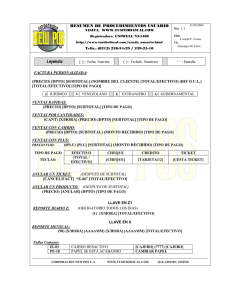
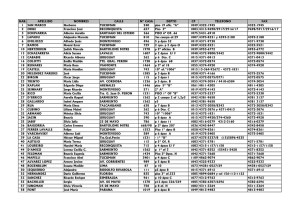
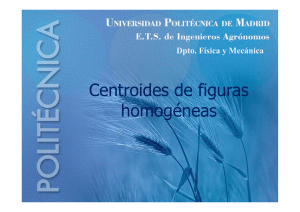
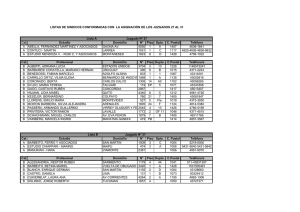
![scarica il catalogo [file ]](http://s2.studylib.es/store/data/005495626_1-8af882935106368e5c31777a94cd019c-300x300.png)
